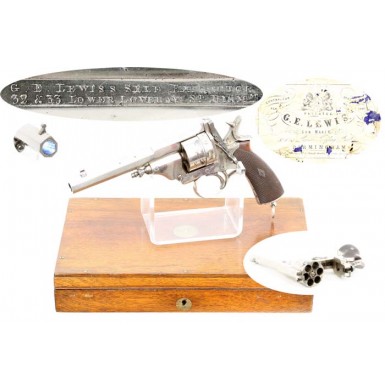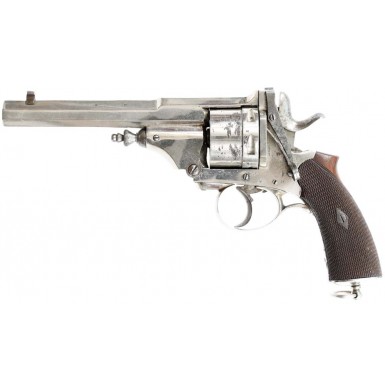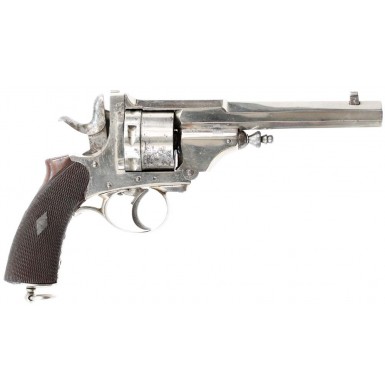G.E. Lewis Cased Revolver - Very Scarce
- Product Code: FHG-1943-SOLD
- Availability: Out Of Stock
-
$1.00
George Edward Lewis was born in Birmingham, England on January 23, 1829, the son of brick maker John Lewis and his wife Elizabeth. Young George was apprenticed in the gun trade at a young age, and by the age of 21 had established himself in business on Bath Street in Birmingham, circa 1850. George had studied art while completing his apprenticeship, and his initial business was as a gun engraver. A year later, the 1851 census described him as a “gun finisher” who was employing five workmen. Within a few years, the company had expanded and by 1859 the firm was described as “gun and rifle makers”, and now occupied a large, newly built factory at 32-33 Lower Loveday Street. Lewis exhibited some of his firearms at the London Exhibition in 1862 and the following year obtained his first (and only) English Patent, #2100 of 1863. The patent was in conjunction with Henry Walker and Joseph Blout Wayne for a drop-down breechloading long arm. Initially, the firm had been general gun trade manufacturers who also did repair work and the associated work that was typical of the Birmingham arms makers of the period. Today we would call them OEM (original equipment manufacturers), who produced items for sale on a wholesale level to other retailers. In other words, Lewis produced guns that did not bear his name, but rather were sold to others in the gun business who would retail them under their name. With the coming of the American Civil War, the firm produced large numbers of Pattern 1853 Enfield Rifle Muskets as part of the Birmingham trade with many of these guns eventually being used to fill Confederate contracts. In addition to exports to the American belligerents, the firm produced arms for export to the lucrative Indian, African and other English colonial markets like Australia and New Zealand. During the Franco-Prussian War, Lewis produced arms for the French government as well. In 1871, the firm entered the retail part of the arms business and began to sell directly to the public in addition to the gun trade. To better serve their new retail clients, the firm established two London retail outlets, one at Duke Street, Manchester Square, Paddington, St Marylebone, and another at 172 Strand. These locations remained in business until sometime during the first decade of the 20th century. The firm exhibited arms in Vienna in 1873 and in Paris in 1878. It was at the Paris Exhibition in 1878 that Lewis introduced their "Gun of the Period", a registered trade name for their high-quality double barreled shotgun available in both hammer and hammerless versions. Sometime thereafter, Lewis introduced a form of recess choke boring for shotguns, and over a period of time he popularized “magnum” small bores (12 and 20 bores with 2 3/4 inch chambers). The firm also exhibited arms in Sydney 1879-80, in Melbourne 1880-81, and in Calcutta in 1884. The firm also produced some handguns for retail sale, but these appear to have been a very secondary venture, primarily to be able to offer such items in their retail salons. From the mid-1870s onward the firm seems to have concentrated solely on the production of high grade sporting arms, primarily shotguns and some double rifles. At one time, the firm boasted that Annie Oakley (aka “Little Sure Shot” or “Little Miss Sure Shot”) used one of their "Gun of the Period" shotguns, but this is difficult to confirm with any reliability. In 1863, a son named George Edward Lewis (II) was born, and another son, Ernest Charles Lewis, was born in 1865. According to the 1901 census G.E. Lewis was recorded as a widower 72 years old, living with G.E. Lewis II and E.C. Lewis, and three of his daughters, at 2 Cambridge Crescent, Edgbaston. In 1909, the name of the firm was changed to George E Lewis & Sons. G.E. Lewis I died on January 17, 1917, and the sons inherited the firm. G.E. Lewis II handled the day to day management of the firm, E.C. Lewis was involved in production and because he was an excellent shot, was responsible for the regulation the firm's rifles. E.C. Lewis won the Birmingham Rifle Club Championship six times and the Gunmakers Association Challenge Cup for five years running. In the very late 1930s two of E.C. Lewis's sons joined the firm, G E Lewis III who became a guardian of the Birmingham Proof House in 1951, and E.C. Lewis. When G E Lewis III died in 1988, the business was sold to John Harris who was a friend of G E Lewis III and worked as a gun stocker for the firm. In 1989, John Harris moved the firm to Unit SF2, 63 Price Street. In 1996 it moved again, to Halesowen. In December of 2003 the name, goodwill and records of G.E. Lewis were sold at auction in London to Grant Dempsey of Broxbourne, Hertfordshire, and in December 2009 they were sold by him at auction in London. The records of the firm date from about 1871, they give descriptions, serial numbers and sales dates. It appears that the firm is no longer a going concern, and it is somewhat sad to see one of the last and longest lived of the Birmingham gunmakers has finally succumbed and is no longer active in the trade.
Offered here is a very rare, break open, G.E. Lewis Self Extractor Revolver produced and retailed by G.E. Lewis, contained in its original retailer casing. The gun is unmarked, with the exception of the topstrap, which is engraved in two lines:
G.E. LEWIS’s SELF EXTRACTOR
32 & 33 LOWER LOVEDAY ST BIRMM
The only other markings are the usual Birmingham commercial proof marks on the barrel and cylinder, and a couple of small, indecipherable letter codes on the front face of the cylinder and on the grip frame, under the grips. The revolver is a six-shot, double action, hinged frame design with a single stirrup release on the left rear of the frame. It has a 5 ““ long octagon to heptagon (7-sided) barrel, with the top flat morphing into a point along the latter two-thirds of the barrel. The revolver is 10 ““ in overall length with two-piece checkered walnut grips and a lanyard ring in the butt. A fixed notch on the upper rear of the top strap and dovetailed blade serve as sights. Although not marked, the revolver appears to be chambered for one of the .442 centerfire cartridges, .442 Webley perhaps. The bore measures .443” with the cylinder chambers measuring .447” at the mouths and .482” at the rear, with the recess for the cartridge rim measuring .518”. The revolver is nickel plated and remains in about FINE condition overall. As there are no patent markings or serial numbers, it is difficult to accurately pinpoint the year of production, but I would guess the revolver was made circa between the early 1870s and the mid-1880s. The design is reminiscent of some of the Webley top-break systems and most closely resembles the Webley-Kaufmann design c1881. As with most top-break, hinged frame revolvers, releasing the latch allows the barrel to be rotated downward, extending the extractor and ejecting the empty cartridges. The fact that the topstrap is marked G.E. LEWIS’s SELF EXTRACTOR suggests that the system is of Lewis’ design, but there is no indication that he ever patented it, or it is possible that it was too similar to other systems already being protected by a patent to receive one. This may explain why these guns are so scarce. Lewis may have only produced a few before he realized that he was likely to be hit with a patent infringement lawsuit, and so returned his efforts to sporting arms. The revolver survives in its original Lewis retailer wood case, with a Lewis retailer label in the lid. The label notes that Lewis is the “patentee”, probably referring to his drop-block patent, as this same label is found in the cases of sporting long arms as well. The label gives the 32-33 Loveday Street primary address, rather than the retail shop addresses, allowing the same label to be used at all locations. The label notes that Lewis is a “contractor for every description of military arms”, harkening back to his days a supplier to the trade and further notes “muzzleloaders converted to breech loaders on every approved principle”, another indication of his early work in the trade. The case is the usual compartmentalized English pattern handgun case, and appears to be made of mahogany. The case is lined with blue baize cloth with single lidded compartment with a turned ivory pull, and additional uncovered compartments for implements. The construction includes the usual brass screws securing the top panel of the lid, brass “bible” hinges and a recessed brass lock and escutcheon. A round brass name plate is centered in the top of the lid.
As previously noted, this G.E. Lewis Self Extractor Revolver is in about FINE condition. The gun retains about 85%+ of the original nickel finish overall, with most the loss being confined to the cylinder, which has flaked and oxidized. The frame and barrel retain more than 90% of their nickel, with some minor wear long the left side of the frame where the action latch has rubbed the finish and some very small areas of lightly flaked loss. There is some lightly scattered surface oxidation on the frame, and a few scattered flecks along the barrel. The cylinder retains about 80% of its nickel, with the loss apparently due to flaking and wear and possibly from storage in the case with the cylinder resting on the cloth. The areas that have flaked have developed an untouched, deeply oxidized patina and some minor roughness. There is also some flaked and oxidized loss on the gripstrap and the backstrap of the revolver. The engraved retailer information on the top of the gun remains very crisp and clear. Both the hammer and frame catch have a mottled gray and brown patina with surface oxidation. The action of the revolver is mechanically EXCELLENT and the gun times, indexes and locks up perfectly. The break open system works correctly as well and the action locks tightly in place when closed with absolutely no wobble or end shake. The extractor system operates crisply and correctly with the action is opened. The bore of the revolver is in about GOOD+ to NEAR VERY GOOD condition. It is mostly bright with crisp five-groove rifling. The bore shows oxidation and darkness for the last couple of inches nearest the muzzle and some scattered pitting as well. The two-piece checkered walnut grips are in FINE condition as well. they are solid and complete with no breaks, cracks or repairs. The checkering remains mostly crisp with only some light wear and lightly scattered handing marks and minor surface mars. The case remains in about VERY GOOD condition. It is solid and complete, with the expected light surface wear, scuffs and mars. The hinges remain tight and sound, and the lock is present although there is no key. The interior retains most the original dark blue baize lining, which shows moderate wear and fading, along with some tears, minor rips and loss. The covered compartment is not structurally sound and the walls are loose and need to be re-glued. This results in the lid falling into the compartment. No accessories are included, except for a small chamber cleaning brush that is probably not original to the gun. The paper label is worn and tattered and only partially legible due to loss.
Overall this is a fine example of a very scarce G.E. Lewis Self Extractor Revolver in its original retailer casing. These rare revolvers do not appear on the market very often, with may be indicative not only of low production numbers but a total lack of success in the market. It is really amazing how little information is available about these handguns, while information about Lewis and his sporting arms is relatively available. This would be a wonderful addition to any advanced collection of 19th century English cartridge revolvers and would also be a wonderful addition to a collection of English sporting arms that included a Lewis “Gun of the Period”. From the standpoint of action development, the gun is an interesting conglomeration of 1870s-1880s hinged frame design features. This is a very attractive and unique revolver that I am sure you will be glad to add to your collection.
SOLD






